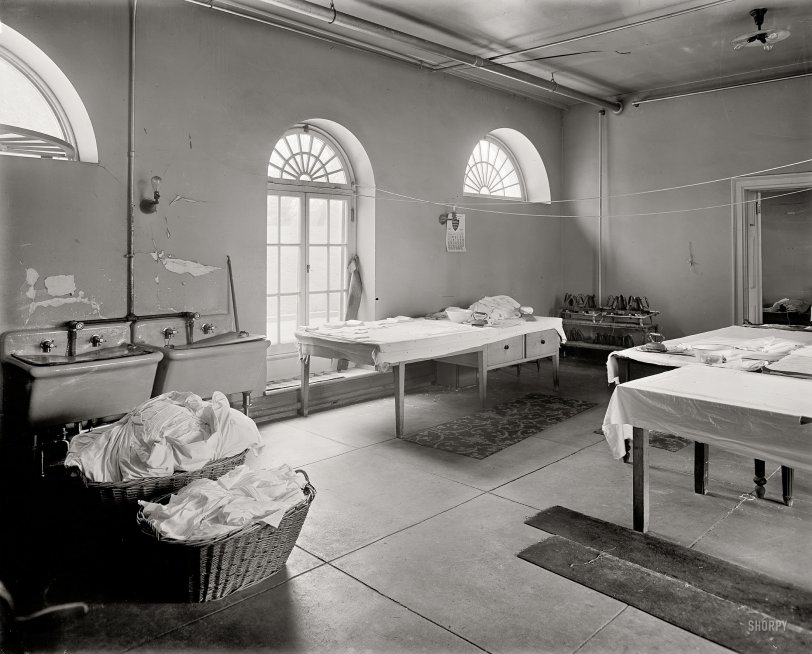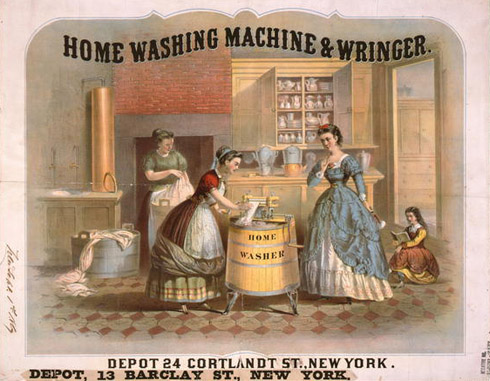


Framed or unframed, desk size to sofa size, printed by us in Arizona and Alabama since 2007. Explore now.
Shorpy is funded by you. Patreon contributors get an ad-free experience.
Learn more.

- Texas Flyer wanted
- Just a Year Too Soon
- WWII -- Replacing men with women at the railroad crossing.
- Yes, Icing
- You kids drive me nuts!
- NOT An Easy Job
- I wonder
- Just add window boxes
- Icing Platform?
- Indiana Harbor Belt abides
- Freezing haze
- Corrections (for those who care)
- C&NW at Nelson
- Fallen Flags
- A dangerous job made worse
- Water Stop
- Passenger trains have right of way over freights?
- Coal
- Never ceases to amaze me.
- Still chuggin' (in model form)
- Great shot
- Westerly Breeze
- For the men, a trapeze
- Tickled
- Sense of loneliness ...
- 2 cents
- Charm City
- What an Outrage
- Brighton Park
- Catenary Supports
Print Emporium
White House Laundry: 1909

"White House laundry." With an April 1909 calendar on the wall and a brace of flatirons in the corner. Harris & Ewing Collection glass negative. View full size.
Rainwater Tap
If our home had a tap for rainwater here in San Diego, it would fill a shot glass about three times a year.
Rainwater
The middle spigot was for rainwater. Rainwater was often collected in cisterns and piped for use in both laundry sinks and bathtubs because municipal water was hard (mineral-rich).
[This wins the prize for Interesting Fact of the Day. Imagine having a tap in your house for rainwater! - Dave]
Spigoted
The middle spigot in each sink -- steam, maybe?
Grandma's electric washtub
I'm from Brazil and can tell you that even nowadays we can find in some Brazilian countryside cities washing machines like that one from 1869's add! My grandmother used to have one like that but with a electric motor adapted on it.
"From swimming pool to press pool"
If I have researched this correctly, this room would later house the indoor swimming pool from 1933 until 1970 when it became an area for the press.
Today, it is the Brady Press briefing room. The pool is still intact underneath the floor. The deep end is under the podium, the shallow end where the cameras are.
This page on the White House Museum site has this very picture at the bottom of the page with an incorrect date of "around 1917."
I guess they couldn't see the writing on the wall!

Laundry Day
By this period, laundry was not so grueling as it once was, but the ironing and sprinkling process was just as awful as ever.
Since very little had been produced yet in the way of synthetic fabrics, all of this was natural fiber: notably linen, the main fabric in use for its softness and durability. Unfortunately linen also takes wrinkles exceedingly well. Starch was used a LOT in the normal laundering cycle, and quite frankly, even with the handy gas-burner irons pictured, it would still have been a harrowing chore.
Looks like they've got their sprinkling bowls out, and those appear to be folded dinner napkins on the left side table.
It's interesting to note that some of the ironing tables appear to be old dining tables with covers tacked on, and the pad for the laundress' comfort looks like a scrap of old dining room carpet.
Presidential Dirty Laundry
William Howard Taft, soiler of the depicted sheets, was the only president to later serve as Chief Justice of the United States, the heaviest president (300+ lbs.) and the last president to wear facial hair in office.
Drudgery
This photo really conveys the drudgery of laundry before washing machines. I weep for the hands that had to work in that room in winter.
[Washing machines made their debut in the mid-19th century. Below, an advertisement from 1869. Motorized agitators and wash drums appeared in the 1890s, heralding the arrival of the "electric laundry." - Dave]

























On Shorpy:
Today’s Top 5